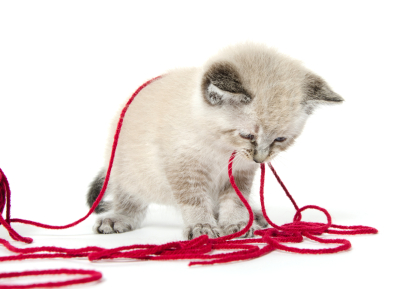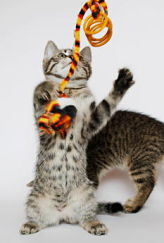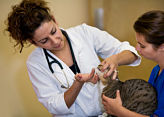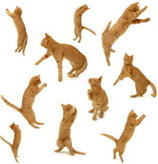Feline Wool Chewing

Feline wool chewing starts out innocently enough. One day you pick up your favorite sweater and find a hole in the arm or another section of it. You are puzzled and then blame moths…but you realize that you just wore this sweater a few days ago…how could moths be that fast? Or you find one of your silk shirts with a wet hole chewed into it.
Like many
cat owners, you realize that the only access to your clothing…was your
cat. At first you think it might have been a food stain that attracted
your sweet little critter but after you find your cat chewing on the
blankets on your bed…you know you have a problem.
After visits to the vet and researching the topic, you find out that feline wool chewing is a form of feline compulsive behavior. A compulsive behavior is a repetitive, consistent behavior that is an abnormal response to normal stimulation from the environment. Feline wool chewing pets find a fuzzy item like a sweater or a blanket irresistible so they start sucking it or chewing it.
Sometimes, the compulsive
behavior can be progressive, whereby the wool sucking leads to feline
wool chewing, which can lead to “pica” (the ingestion of inedible
objects). It appears to be displaced nursing behavior and it may be the
feline equivalent of human thumb sucking.
This compulsion can cause a cat to suck and eventually chew on substances other than wool, such as cotton. Items such as plastic bags, shower curtains, and even rubber bands may also be chosen although those substances seem to be frequently ingested rather than sucked or chewed on. Some start with one fabric and progress to others while others prefer one fabric and keep coming back to it.
Feline wool chewing frequently starts before the age of six months, shortly after the kitten is weaned. It is at this time that the kittens are often separated from their mothers and siblings. In their new homes, as much as they may be loved by their human owners, the kittens can become lonely and inactive.
This is especially true if there are no children in the household and the owner works away from home all day. This may be when the wool sucking starts, leading to feline wool chewing. It is a form of comfort to the kitten and you can actually view a kitten’s eyes glaze over when it is sucking…a sign that the kitten is contented.
However, an anxious animal or one in conflict may engage in a compulsive
behavior as a way of relieving anxiety. Some cats lash out when they
are upset by becoming aggressive to other pets in the household, while
others self-destruct and engage in a compulsion.
In some cases the feline wool chewing doesn’t begin until 2 or 3 years old.
It can be triggered by bringing another animal into the household.
Having to share the owners and other belongings can be stressful to some
cats and a cat weaned young and separated from its mother early tends
to be predisposed to compulsive behavior.
It can also be triggered by separation anxiety…like your cat seeing you packing your bags for a trip. It is believed that it may involve the regulation of the brain chemical serotonin. Oftentimes, owners are unaware of the behavior until they find a gaping hole in something and find out the culprit is the cat.
According to the Cornell Book of Cats: A Comprehensive Medical Reference for Every Cat and Kitten feline wool chewing is especially prevalent in Siamese and Burmese cats. This is an indication that the compulsive behavior may have genetic roots. Even if your cat doesn’t look Siamese or Burmese, one of her close relatives may have been, and so she too may be genetically predisposed to chew wool. Over 50% of the affected cats have that particular heritage.
A cat can be predisposed to feline wool chewing but
never show signs of the behavior until it is exposed to some form of
conflict. It may be a very mild form of conflict, a situation that
other cats could accept fairly easily, but it disturbs this cat.
Possible solutions are to play games with your cat, give it plenty of
attention, eliminating access to the substance, enriching the
environment, exercising, redirecting the cat’s oral needs, and possibly
medicating the cat…these are all steps that may help your cat handle her
compulsive behavior.
Just remember, do not under any circumstances punish the cat. Whether she’s chewing because she’s anxious or because she’s genetically predisposed to doing so, punishing her will only make matters worse. It will just make the cat more anxious or she will just wait until you’re not home.
Some owners with feline wool chewing pets just give in and let them have their way. If this is your course of action, remember one thing…you’ll need to be vigilant and watch your cat carefully for signs that she’s having problems caused by ingesting what she’s chewing. Cats have been diagnosed with intestinal blockages requiring feeding tubes and surgery.
Cats vomit a lot because they get hairballs but this will look different…and the cat will stop eating and act different. Because of these dangers it is advisable to try and stop the feline wool chewing. But be prepared, it can be a difficult behavior to break, probably because it gives some comfort to the cat.
Feline wool chewing presents a classic nature vs. nurture dilemma. Should you try to change your cat’s behavior? Or, is medication the only thing that will help? Try these exercises with your cat and see if she’ll break the habit herself.
- Remove the offending substance. If your cat likes your throw rug, get rid of it. If she likes sweaters, put them all in a closet and close the door. It if’s bed linens she craves, keep her out of the bedroom.
- Enrich her environment Buy her new toys and spend time playing with her. Get a climbing post so she can stay amused. Sit her on your lap and pet her while you watch TV. Play hide-and-seek with cat treats. There are different feeding stations where the cat has to search for its food and some cats enjoy “food puzzles” usually available at a pet supply store. You can even make your own by taking an empty toilet paper roll or paper towel roll and poking holes in the tube large enough to let the crunchies out. You will have to show your cat how to roll the tube in order to get the food out. The main purpose is to keep the cat stimulated and occupied
- Daily exercise routines…Spend 10-20 minutes a day involved in interactive play with your cat. Get the toys your cat responds to like feather wands etc. Give your cat a furry toy with catnip in it, it makes a good replacement.
- Don’t punish her. When you see her begin to chew, gently remove her from the item, and try to get her to play with you. Never punish the cat. It will only make matters worse by elevating her anxiety level. Some vets will prescribe fluoxetine or clomipramine to help normalize brain chemistry and help them have calmer moods.
Cats are creatures of habit and having a stable routine for feeding times, play times and sleep times helps to normalize their daily activities. Although you may not stop the feline wool chewing behavior entirely, by taking a few of these steps you may curtail the frequency.
Related Articles......
Return from Feline Wool Chewing to Cat Health Detective Homepage
Having trouble finding what you need? Cat Health Index & Site Map
OR
Do you have a question to ask?...Questions
OR
Do you have a cat story to share?...Simply click here to go to that page!
Copyright@2010-2020 All rights reserved.Cat-health-detective.com
This website is information only. Consult a veterinarian for medical assistance

"Like Us" on Facebook
or...
"Like Us" here




















